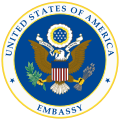Embassy of the United States, Dhaka | |
|---|---|
 | |
| Location | Dhaka |
| Address | 12 Madani Avenue, Baridhara |
| Coordinates | 23°47′48″N90°25′20″E / 23.7967°N 90.4223°E |
| Ambassador | Tracey Ann Jacobson (Chargé d'Affairs ad interim) |
| Website | bd |
The Embassy of the United States of America in Dhaka is the diplomatic mission of the United States in Bangladesh. It is located in Baridhara. The embassy has 400 staff led by the US Ambassador to Bangladesh.

